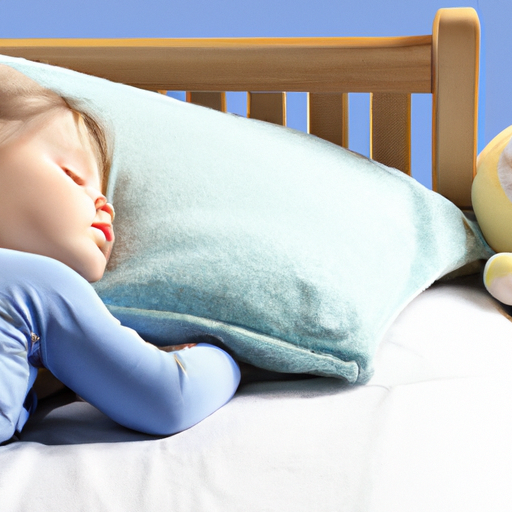Are you struggling to get your baby to sleep through the night? If so, you’re not alone. Many parents face the challenge of establishing a sleep routine for their little ones. In our upcoming article, we’ll explore some practical tips and strategies that can help you create a consistent sleep routine for your baby. From setting a bedtime routine to creating a sleep-friendly environment, we’ll cover all the essential steps to promote better sleep for your baby. So, if you’re looking for some guidance on how to establish a sleep routine for your baby, stay tuned for our detailed article coming soon. Establishing a sleep routine for your baby is crucial for their overall development and well-being. A consistent and structured sleep routine promotes healthy sleep habits, regulates sleep-wake cycles, and ensures that your little one gets the rest they need at different stages of their growth. In this article, we will guide you through the steps to create a suitable sleep environment, establish a consistent bedtime routine, implement naps into the routine, address sleep challenges, maintain consistency and flexibility, and monitor and track your baby’s sleep patterns.
The Importance of Establishing a Sleep Routine
A sleep routine is not only important for your baby’s sleep but also for their overall health and happiness. When you establish a consistent sleep routine, it helps your baby develop healthy sleep habits. Having a predictable sleep routine allows their body to recognize when it’s time to sleep and wake up, which ultimately regulates their sleep-wake cycles. This, in turn, helps your baby sleep better and ensures they get the rest they need for optimal growth and development.
Understanding Baby’s Sleep Patterns
Before diving into establishing a sleep routine, it’s essential to understand your baby’s sleep patterns. Newborns have irregular sleep patterns, sleeping for short periods of two to four hours at a time. As they grow, they will start to develop more predictable sleep patterns. By the time they reach three to six months, they may sleep for longer stretches at night, with multiple naps during the day. By one year old, most babies will have consolidated their sleep into longer stretches at night and fewer daytime naps.

Creating a Suitable Sleep Environment
Creating a suitable sleep environment plays a significant role in helping your baby establish a healthy sleep routine. Start by choosing the right crib and mattress that meets safety standards. Ensure the crib is set up in a safe location away from any hazards, such as cords or curtains. It’s also important to set the ideal room temperature, keeping it cool but not too cold or hot. Maintain a calming atmosphere in the room by using low lighting, white noise machines, or soft music.
Establishing a Consistent Bedtime Routine
A consistent bedtime routine sets the stage for a good night’s sleep. Start by selecting pre-sleep activities that signal bedtime is approaching. Dim the lights in the house and engage in quiet, calming activities such as reading a bedtime story or singing a lullaby. Incorporate soothing techniques such as gentle massages or rocking your baby. Bathing and nighttime nursing can also be included in the routine. Make sure to keep the routine consistent, doing the activities in the same order and at the same time every night.

Implementing Naps into the Routine
Naps are an essential part of a baby’s sleep routine. Determining appropriate nap times depends on your baby’s age and their individual needs. As a general guideline, newborns may need up to 18 hours of sleep a day, including naps. By three months, babies typically take three to four naps a day. Around six months, they may transition to two or three naps, and by one year old, most babies will take one or two naps a day. It’s important to develop a nap schedule that works for your baby and stick to it consistently.
You can find more information about the benefits and importance of naps in our article on how to encourage your baby to take naps during the day.
Dealing with Sleep Regression
Sleep regression is a temporary disruption in a baby’s sleep pattern. It commonly occurs at different stages of development, such as around four months or during teething. Recognizing the signs of sleep regression is key to addressing it effectively. Your baby may experience increased night wakings, difficulty falling asleep, or changes in their nap patterns. To overcome sleep regression, be patient and provide extra comfort and reassurance during this challenging phase. Stick to your established sleep routine, and try incorporating soothing techniques that have worked for your baby in the past.
You can find more information about common baby sleep regressions and how to handle them in our article on common baby sleep regressions.
Addressing Sleep Challenges
It’s common for babies to face sleep challenges along the way. Night wakings and feeding go hand in hand, especially for younger babies who still need nighttime feedings. Gradually, as your baby grows, they may naturally drop their nighttime feedings. Teething can also disrupt your baby’s sleep. Provide comfort and soothing measures such as teething toys or gentle massages to alleviate discomfort. Another significant sleep challenge is transitioning from a crib to a toddler bed. Introduce the transition gradually, ensuring your child feels safe and secure in their new sleeping environment.
To learn more about baby-proofing your home and creating a safe sleep environment, check out our article on how to baby-proof your home.
Maintaining Consistency and Flexibility
When it comes to establishing a sleep routine, maintaining consistency is key. Stick to the established sleep routine to help your baby recognize sleep cues and develop healthy sleep habits. However, it’s also important to be flexible and adjust as necessary. As your baby grows and reaches different developmental milestones, their sleep needs may change. Be open to adapting the routine to accommodate these changes while still focusing on maintaining consistency as much as possible.
Monitoring and Tracking Sleep Patterns
Monitoring and tracking your baby’s sleep patterns can provide valuable insights into their sleep habits and identify any concerns or patterns of sleep disruption. Keeping a sleep diary can be helpful in recording your baby’s sleep times, nap durations, and any notable changes or challenges. There are also sleep tracking apps available that make it easier to monitor and analyze your baby’s sleep patterns. However, it’s important to remember that these tools should not replace professional advice or consultation with a pediatrician if you have concerns about your baby’s sleep.
Conclusion
Establishing a sleep routine for your baby is a process that requires patience and consistency. By creating a suitable sleep environment, implementing a consistent bedtime routine, incorporating naps, addressing sleep challenges, and maintaining flexibility, you are setting your baby up for healthy sleep habits. Keep in mind that every baby is unique, and what works for one may not work for another. Trust your instincts and adapt the routine to cater to your baby’s individual needs. Remember, a well-rested baby is a happy and healthy baby.




